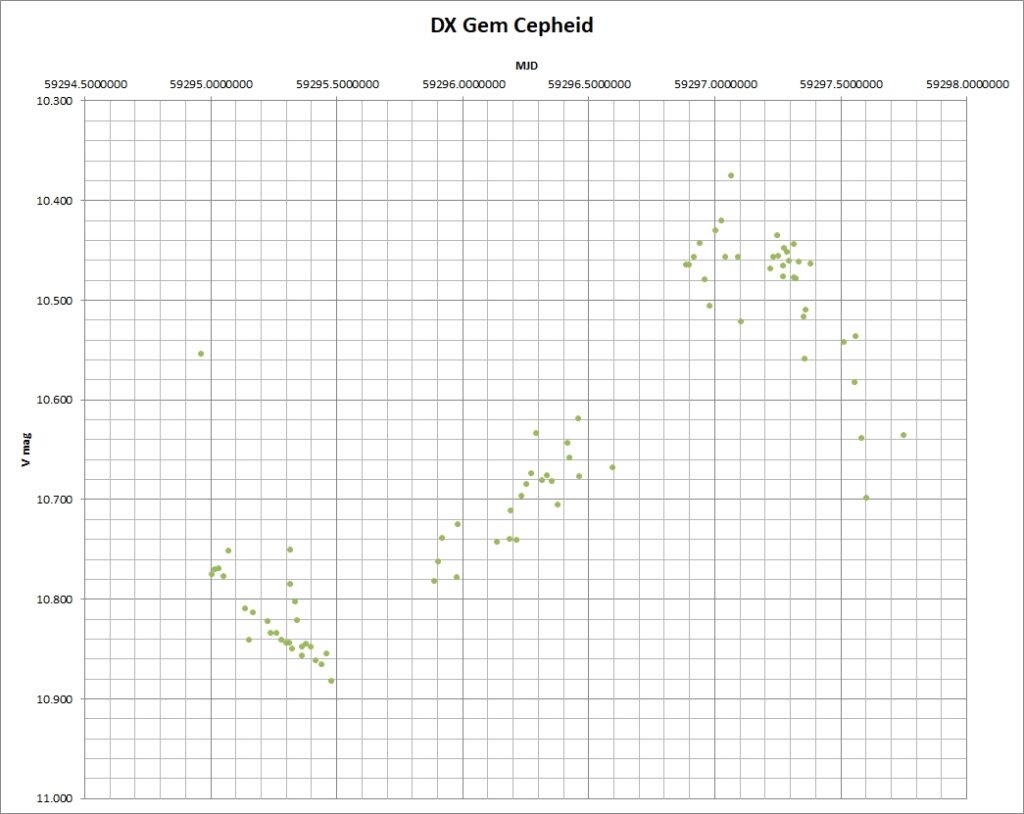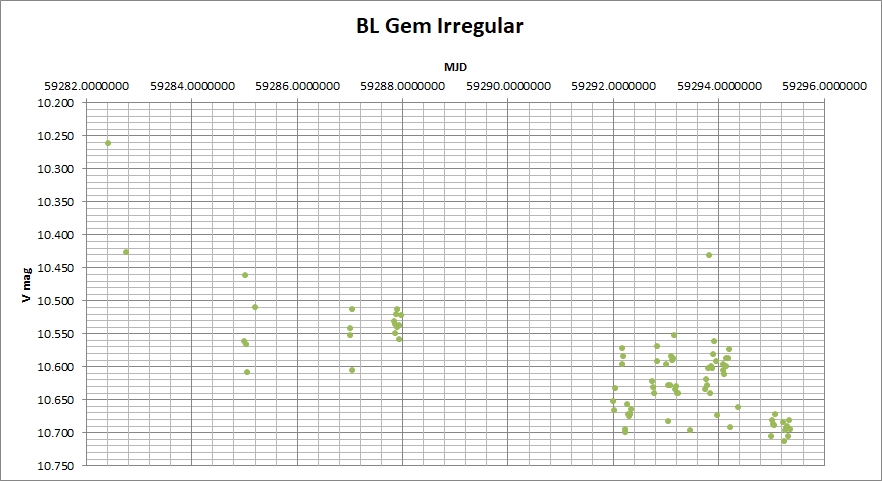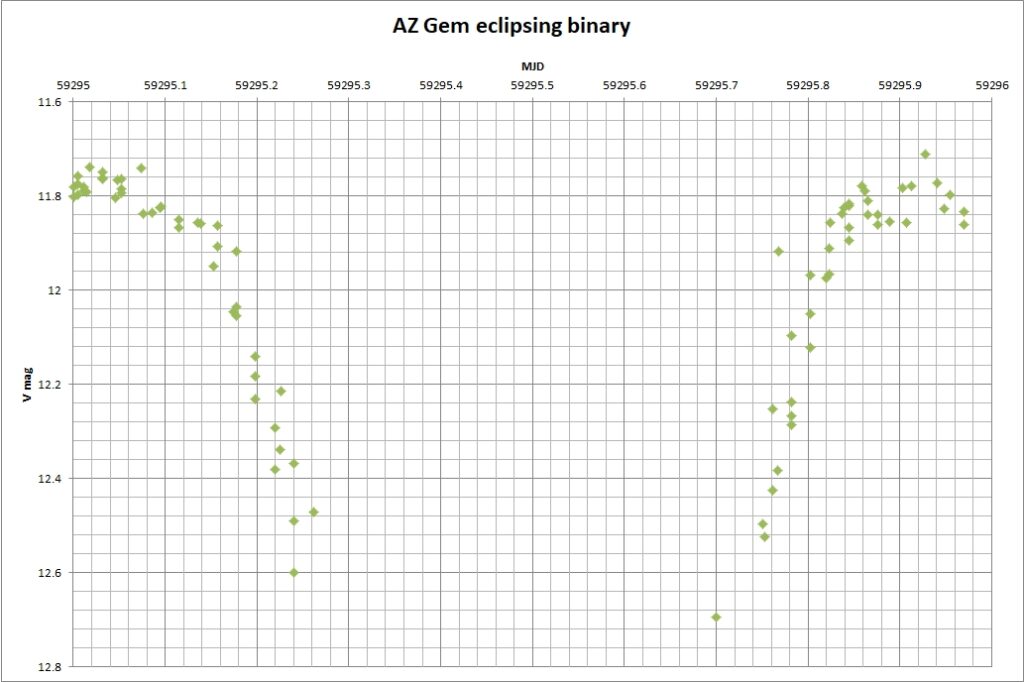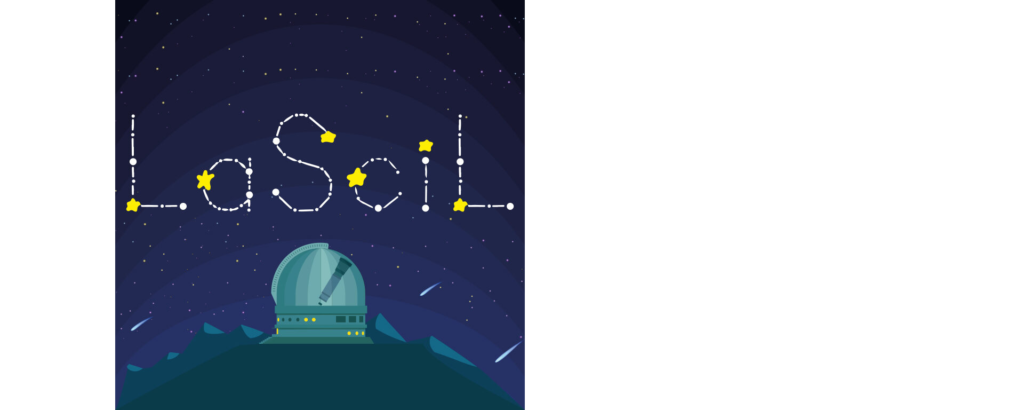 Via our parent organisation, the Dill Faulkes Educational Trust (DFET), we at the Faulkes Telescope Project are proud to be leading an EU Erasmus+ project called LaSciL.
Via our parent organisation, the Dill Faulkes Educational Trust (DFET), we at the Faulkes Telescope Project are proud to be leading an EU Erasmus+ project called LaSciL.
LaSciL stands for Large Scientific infrastructures enriching online and digital Learning and aims to support high quality science teaching, through the use of data archives and innovative online tools.
Along with our colleagues in Greece, Portugal and Austria, we are supporting teachers in using these tools to:
-
create educational resources for students in open and distance learning;
-
manage large numbers of students in an online environment and keep them motivated to participate;
-
personalise teaching practices based on students’ needs.
As with many EU projects, LaSciL will is running a couple of ‘summer schools’. In 2022, we were lucky enough to visit Heraklion in Crete. In February 2023, it will take place in a dark sky reserve called Alqueva in Portugal. We have funding to provide UK teachers with flights and accommodation for these weeklong trips so if you’re interested, please contact us.
More details can be found here for the project (https://lascil.eu/) and the summer school (https://esia.ea.gr/lascil-winter-school-2023/).
Or contact us for more details by emailing fraser.lewis (at) faulkes-telescope.com

In the morning, we’ll be discussing the EU project CliC-PoLiT which examines the role astronomy can play in challenging the issues around climate change and light pollution.
In the afternoon, we’ll look at how teachers can make the most of the free telescope time and resources that the Faulkes Telescope Project provides to teachers and educators worldwide.
The timings are as follows …
Lichtverschmutzung (Light Pollution), EU-Projekt, CliC-PoLiT
9:00 – 9.15: Welcome / warm up (Lothar Kurtze, Martin Metzendorf)
9:15 – 10:00: Classroom activities about light pollution, how to evaluate light pollution by observing stars (Gustavo Rojas)
10:00 – 10:15: Coffee break
10:15 – 11:00: Earth at night: workshop with images from ISS (Lothar Kurtze, Jenny Brüggler)
11:00 – 11:45: How dark is the sky at the LCO observatories? Classroom observations with the Las Cumbres Observatory (LCO) 0.4-m Network (Fraser Lewis)
11:45 – 12:00: Discussion / final words (Lothar Kurtze)
Workshop Faulkes Telescopes, Arbeiten mit den über Internet gesteuerten Teleskopen
13:00 – 13.15: Welcome / warm up (Lothar Kurtze, Martin Metzendorf)
13:15 – 13:45: Workshop 1: How to plan an observing session (Fraser Lewis)
13:45 – 14:15: Workshop 2: Observing with the FT/LCO telescope network (Lothar Kurtze)
14:15 – 14:30: Coffee break
14:30 – 15:00 Workshop 3: How to use the image archive (Fraser Lewis)
15:00 – 15:30: Spectroscopy (Herbert Pühringer)
15:30 – 16:00 Discussion / final words (Lothar Kurtze)
For more information, please contact Lothar via e-Mail: FTP-Europlanet@online.de
]]>

Via our parent organisation, the Dill Faulkes Educational Trust (DFET), we at the Faulkes Telescope Project are proud to lead an EU Erasmus+ project called LaSciL.
LaSciL stands for Large Scientific infrastructures enriching online and digital Learning and aims to support high quality science teaching, through the use of data archives and innovative online tools.
With our partners in Greece, Portugal and Austria, we will aim to support teachers to use these tools to:
- create educational resources for students in open and distance learning;
- manage large numbers of students in an online environment and keep them motivated to participate;
- personalise teaching practices based on students’ needs.
For UK-based teachers, we are looking to conduct some ‘multiplier’ events in the next few months, either face-to-face or online. Here, we will be able to demonstrate resources based primarily around robotic telescopes but also showcasing our colleagues’ work in their specialist areas. Our online events will also be available to attend (for free) for teachers and educators wherever they are in the world.
Please contact us for more details by emailing fraser.lewis (at) faulkes-telescope.com
As with many EU projects, LaSciL will run a couple of ‘summer schools’. This year, it will be from July 3 to 8 in Heraklion, Crete and next year, it will take place in Portugal. We have funding to provide UK teachers with flights and accommodation for these weeklong trips so if you’re interested, please contact us.
More details can be found here for the project (https://lascil.eu/) and the summer school (https://esia.ea.gr/lascil-summer-school/).

Interacting Galaxies
During the first term this year, students in the Nottingham High School Astronomy Club and Year 9 used the robotic telescopes to observe galaxies in the process of colliding. Students took new images of interacting galaxies such as M51 and NGC 7318 (part of Stephan’s Quintet) using the real-time interface and the observing portal. This was particularly challenging since many of the galaxies we observed are very faint like NGC 6050 in Figure 1 and require very long exposure times
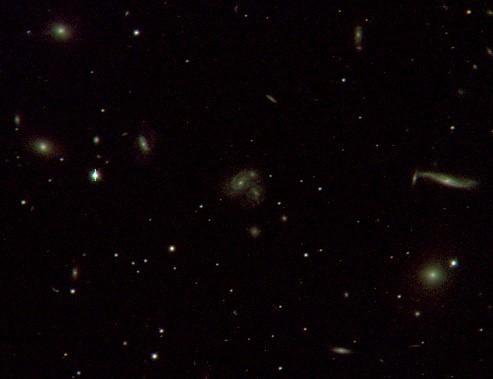
These images formed the centre of a Year 9 class activity during their Astrophysics topic. The students were given the red, green, and blue FITs files and shown how to create a colour image using an online FITs editor. Students classified the interacting galaxies as about to merge, merged, or already merged!
This facilitated lots of interesting discussions about the Physics behind galaxy mergers, galaxy evolution, and what happens when two black holes collide.
Comets
Last September schools were asked by the Faulkes Telescope Project to observe the Comet 29P/Schwassmann-Wachmann which had suddenly increased in activity, making it much brighter in the night sky. Our students readily accepted this challenge and managed to observe Comet 29P on two occasions using the 2-metre robotic telescope and another Comet (17P) undergoing a similar outburst.
We took this opportunity to learn about comets and made a model comet out of dry ice for our celebrations during World Space Week. Figure 2 shows one of our Comet images taken by our students.
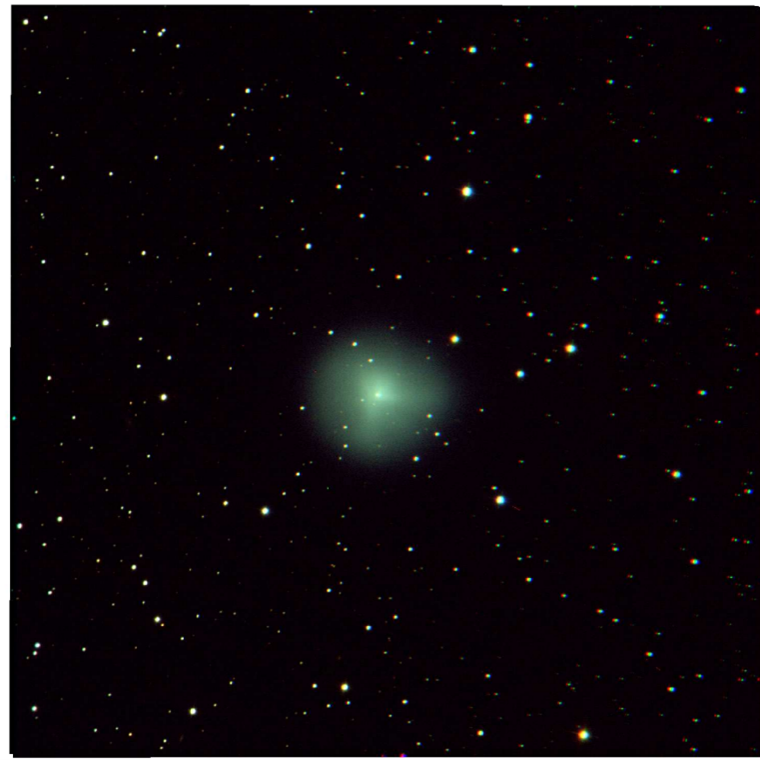
A Level Astrophysics
As part of our Year 13 instruction, some students had the opportunity to use one of the telescopes during our daylight hours. After a few attempts at getting the telescope to face the live webcam the students could see the structure of the telescope was just like they had learnt about in class. Students had the opportunity to observe many of the objects we had been talking about throughout the course.
We then used data from the observatory archives to create our own colour-magnitude diagrams. Figure 3 shows a colour-magnitude diagram where the colour axis has been converted to temperature. Students were able to learn all about photometry and use special software to extract the magnitudes of stars in their chosen open cluster.
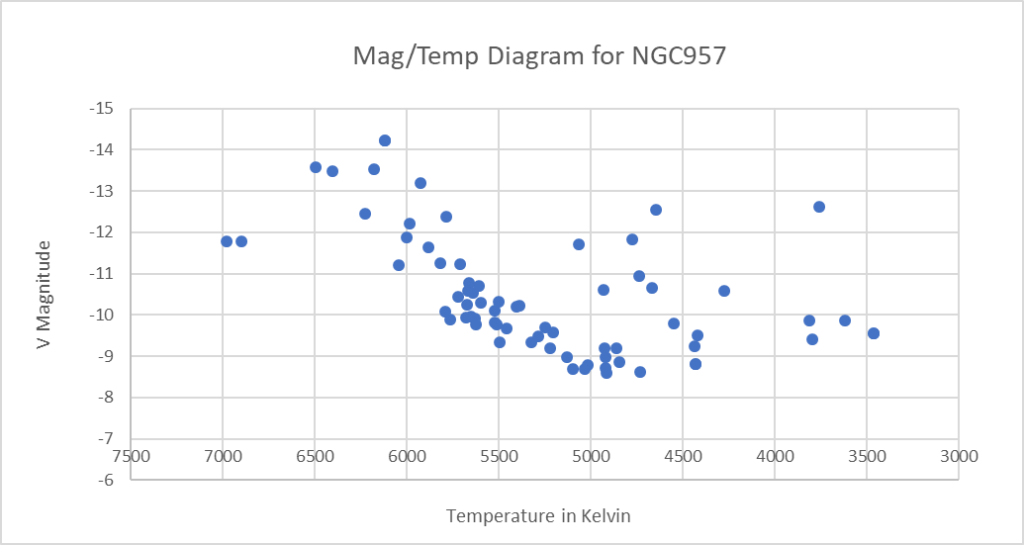
The experience of using the telescopes and creating images from them is invaluable for our students. As a Year 9 said “Wow, is that real?”. One of our younger Year 7 students said “The telescope was legendary, it took a beautiful image. It was super precise, allowing us to exactly see galaxies and all their features. The best telescope I have looked through.”
]]>Instructions:
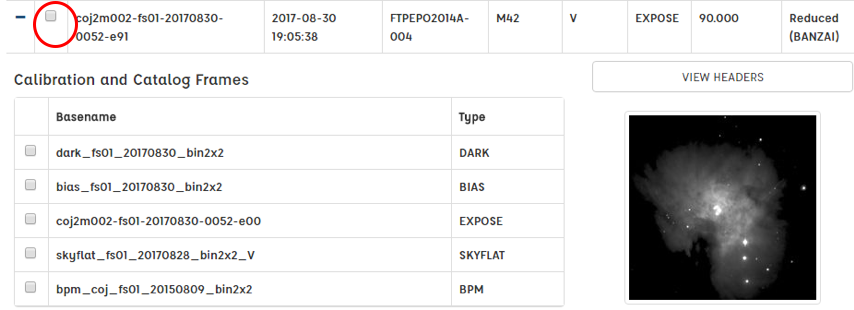
If you want to download images from the LCO data archive, tick the small box to the left of the Basename of the image(s) you want (as circled on the left) and click the blue ‘Download’ button at the top of the page. There are 2 options which you can choose:
1. zip download (with compressed fits files) or
2. zip download (with uncompressed fits files).
If you choose option (1) then your files will be the .fits.fz format and whatever software package you use to open the files must be able to display .fz files. If you choose option (2) then your file sizes will be larger, but you can use any software package that opens .fits files to open your data.

By André Debackère and Paul Roche
In February, Vegard Rekaa (a school teacher in Norway, and part of the Online Observatory project working with FTP) asked Paul Roche if he could observe some Cepheid variables. Paul forwarded this request to André Debackère in France, who proposed a list of these variables that can be observed with the 0.4m telescopes of the LCO network. André asked his existing school collaborators, Conrad Stevens (England) and John Murphy (Ireland), to participate in this new observing programme.
After consulting a list of targets amongst Galactic Classical Cepheids, our choice fell on stars whose luminosity is suitable for telescopes of 0.4m in diameter and whose period is short enough to be easily studied in a few weeks.
André Debackère suggested to observe the Cepheid named DX Gem. He realised that the 0.4m telescope field of view (19’ x 29’) would allow 3 other variables to be observed at the same time.

And so the “Four nations observing four variables” project had begun – and with France, Ireland, Norway and England working together, this could be a FINE collaboration 
The main target:
DX Gem
Cepheid, V range 10.53-10.92, Period = 3.1 d
The other variables are:
V0350 Gem
Long period Mira Ceti type, V range 11-14, Period ~444 d
BL Gem
Irregular variable, V~10.7, Period ~51.5 d
AZ Gem
Eclipsing binary in contact EB type (Beta Lyrae type), V range ~11.8-12.4, Period = 1.0 d
Our results:
Following a few successful observing runs for each partner during March, lightcurves were produced for all 4 variable stars. Data has been obtained in several filters (B,V and r’), so an investigation of colour changes can also be undertaken by students. The initial lightcurves below (V band data only) show clear evidence for variability in each target.
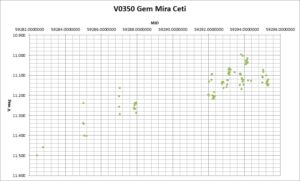
The team plan to continue monitoring this field, and will be updating their data archive over the next few months – so look out for new results! In particular, we will be looking not only at how the brightness of each star varies, but also how the colour changes with time, and finding out what that can tell us about the astrophysics going on in each case.
]]>In early 2018, the ESA Gaia spacecraft was busy observing the cosmos, detecting points of light in space as part of its mission to map out the physical features of our Galaxy. In Eastbury Community School, Barking, Essex, Megan Greet, the Head of Physics, was working on a project with her Year 13 students, which involved using the robotic Faulkes Telescopes to help identify exploding stars, or supernovae, in Gaia’s data. One object however stood out for the group – instead of showing the typical lightcurve of an exploded star, this object’s lightcurve looked different. Data was collected by pupil Jorgen Kolgjini, and collated by astronomer Dr Jaroslav Merc (Astronomical Institute of Charles University in Prague) to analyse. Further data was taken and the results discussed.
The outcome – Gaia18aen was not a supernova but a symbiotic star.
Merc explains further:
“Symbiotic stars are binary stars that typically consist of a cool evolved giant (usually of a spectral type K or M, meaning that they are cooler than the Sun) and a very hot and luminous white dwarf. The giant is losing mass in the form of a stellar wind. Part of it is accreted by the white dwarf. This interaction results in observable effects such as significant photometric brightenings (so-called outbursts) or changes in the spectroscopic appearance.”
Image 1 shows an artist’s illustration of a symbiotic binary system. Here you can see where the giant star is losing mass to the white dwarf forming an accretion disk and resulting in bipolar outbursts from the white dwarf.

Merc commented, “These objects are very interesting astrophysical laboratories. You can study the mass transfer, accretion of matter, stellar winds, jets, the formation of dust, and other astrophysical phenomena. Symbiotics are also important for the study of the evolution of binary stars.”
This was the very first discovery of a symbiotic star by the Gaia mission and proves that besides its mission to accurately measure the precise positions of stars in our Galaxy, Gaia can also be used to detect new types of interesting stars, and school pupils can help with these discoveries!
Merc also went on to comment on the relatively recent rapid increase of known symbiotic stars, which he has attributed to more specialist surveys of stellar objects, but also how this number of known symbiotic stars is still much lower than any estimate of the total population of symbiotic stars. He suggests that many of the symbiotic stars that we know about are often only discovered by “coincidence” as opposed to being sought out by space telescopes or probes like Gaia.
Fraser Lewis from the FT Project commented “We were delighted to be a part of this research, especially as it involved a teacher and her pupil contributing to an exciting astronomical discovery”.
It was this “coincidence” of Gaia18aen’s discovery by Jorgen Kolgjini and his teacher, Megan Greet that has led them to be included as authors on the published paper documenting the discovery of Gaia18aen – not bad for a day’s work in school!
For more information on the Gaia mission and how you can get involved visit https://www.gaia.ac.uk/ Or contact the Faulkes Telescope Project directly on info@faulkes-telescope.com
]]>In the afternoon, Helen Usher and Paul Roche (FTP), working with Richard Miles and Tony Angel of the British Astronomical Association (BAA) working with 13 primary school teachers to kickstart the STFC-funded “Comet Chasers” project, being led by Techniquest science discovery centre in Cardiff Bay. The teachers were introduced to comets, and also to galaxies, as the project will be using the example of Charles Messier, who developed his famous catalogue of “deep sky objects” to avoid confusion with his comet hunting. The Comet Chaser schools will be working with FTP and the BAA to gather data on several comets that will be visible in March – May, before (hopefully!) coming together for a big finale event at Techniquest in July.
Later that day, Paul was back in action with IOP Wales, in an early evening session entitles “Observing the night sky – stars and Mars”, this time working with Pete Williamson (AstroRadio and Solarsphere) and Emma Wride (AstroCymru). At it’s peak there were 79 (mostly secondary) teachers in the audience, learning about how to use Stellarium to locate objects in the night sky. A planned “go outside and watch the ISS and Starlink satellites go over!” event in the break was scuppered by bad weather for almost all the participants, although a luck few (notably in the Anglesey area!) did manage to catch the impressive overpasses.
The ESERO-UK website, and in particular the substantial classroom resource archive, were showcased, as well as various pieces of free software and websites that will assist the teachers in using astronomy and space as topics to inspire their students.
In total, just over 6 hours of CPD was delivered to just over 90 teachers – a great start to the year, and an indication of the power of online delivery for reaching large numbers of teachers across the country!
]]>Since 2015, the Instituto de Astrofísica de Canarias (IAC), together with several educational institutions, has been organising an international summer course for teachers with the aim of showing them the potential of Astronomy to awaken interest in the STEAM areas (Science, Technology, Engineering, Arts and Mathematics), as well as providing them with the tools and knowledge to carry out research projects with their students, encouraging critical thinking and the development of scientific and technological skills.

Origins of the participants in the 2020 IAC Astronomy Adventures
The 2020 edition was to be held at the IAC’s facilities in Tenerife and La Palma, but due to global mobility restrictions related to the COVID-19 pandemic, it was decided to organize it in a virtual mode. The course took place from 20 to 24 July, in morning and afternoon sessions taught live using videoconferencing software. This format has allowed the participation of a high number of teachers from all over the world: about 170 attendees connected to the online sessions and a dozen more have followed the training through recordings and the virtual campus. This is the edition that has had the most participants and also the most international one, since the attendees come from 40 countries from four continents (Europe, Africa, America and Asia). In the five previous editions, a total of 140 educators from 12 countries, almost all European, have been trained.
The opening session was presented by the course coordinators, Nayra Rodríguez and Rosa Doran, and included a speech by the IAC’s Deputy Director, Casiana Muñoz, who welcomed the participants and highlighted the importance of the teachers’ work in getting new generations interested in science and seeing it as a tool for the joint progress of society.
Exploring other worlds from the classroom (or from home)
The central theme of the training was the “Exploration of stars and other worlds”. Lectures have been given on the stars and the planets that orbit them, how these objects are detected, how their properties are studied and what the latest advances are in these fields of Astrophysics. Furthermore, through workshops and practical activities, the necessary tools and knowledge have been presented so that teachers can develop scientific projects with their students that allow them to discover exoplanets, variable stars or supernovae, as well as investigate these objects from their own observations with robotic telescopes or using archive images obtained with the telescopes of the Observatories of the Canary Islands or with the ESA’s space missions.
Robotic telescopes: online Astronomy Labs
The training is part of the IAC’s Educational Project with Robotic Telescopes (PETeR) The training is part of the IAC’s Educational Project with Robotic Telescopes (PETeR), which enables the Spanish educational community to carry out its own research on the Universe using professional robotic telescopes, such as the Liverpool Telescope at the Roque de los Muchachos Observatory or the Las Cumbres Observatory telescopes at the Teide Observatory and five other locations around the world. Teachers have learned to program observations with these telescopes, as well as to use astronomical image viewing and analysis programs specially developed for educational use.
In addition, the robotic telescope projects National Schools’ Observatory (NSO) and Faulkes Telescope Project (FTP), open to UK-Ireland and international schools respectively, were presented.
Organizers
The course was organized by the IAC’s Outreach and Communication Unit in collaboration with the Núcleo Interactivo de Astronomia (NUCLIO, Portugal), the FTP and NSO projects (United Kingdom) and the educational initiatives CESAR – Cooperation through Education in Science and Astronomy Research (ESAC, ESA-INTA-ISDEFE, España) and “CosmoLAB: El Sistema Solar como laboratorio en el aula” (IAC, Tenerife , all of which are institutions and projects aimed at promoting interest in science among schoolchildren through astronomy and related areas. It has also been partially funded by the European project Our Space Our Future.
The participants have had the opportunity to get to know and practice with some of the educational resources developed within the framework of these projects, which broadens the range of tools and resources presented, in addition to those of the PETeR project.
The people who have made this training possible are the following:
Coordinators, speakers, tutors and moderators: Nayra Rodríguez (IAC) and Rosa Doran (NUCLIO)
Speakers, tutors and moderators: Fraser Lewis (NSO, Faulkes Telescope Project), Sandra Benítez (IAC), Beatriz González (CESAR) and Michel G. Breitfellner (CESAR)
Speakers: Héctor Socas (IAC) and Felipe Murgas (IAC)
Technical and organisational support: Ana Costa (NUCLIO), Gustavo Rojas (NUCLIO) and Diego Sierra (IAC)
Audiovisual support: Inés Bonet (IAC) and Iván Jiménez (IAC)
Social media support: Teresa Direitinho (NUCLIO), Iván Jiménez (IAC), Alejandra Rueda (IAC) and Aarón García (IAC)
More information:
- Course website (in Spanish)
- Press release: “The International Summer Course for teachers celebrates its sixth edition in ‘online’ format”
Previous editions:
In Cooperation with the Planetarium Münster, teachers from Pascal-Gymnasium, Ratsgymnasium Münster and Nepomucenum Coesfeld took part in the first online-training (“Astronomy 2.0”). This was held “online” not only because of the Coronavirus, but also because this is a normal way of working in modern scientific work – this is the era of Astronomy 2.0!
In two conference sessions of 2.5 hours each, the teachers learnt how to work with students using the 23 LCO research telescopes accessible through the Faulkes Telescope Project, and how to evaluate astronomical images created.
Optionally, the teachers had the opportunity to control the 2-meter Faulkes Telescope South in Siding Spring, Australia, and Faulkes Telescope North, Hawaii, directly in special sessions (using the remote control mode).
First remote session (Wed, May 13, 2020 / 8:15-8:45 UT)
Real Time Interface with the 2m Faulkes Telescope South (FTS): observations of the galaxies NGC 2997 and NGC 5128 were obtained with different colour filters (RGB, each 120s). Michael Weiermann from Nepomucenum Coesfeld made several colour images, including this one of NGC 5128:
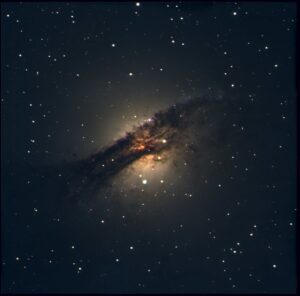
Second remote session (Thu, May 14, 2020 / 8:15-8:45 UT)
Real Time Interface of the 2m Faulkes Telescope South (FTS): this time, the task was to capture the comet NEOWISE (C/2020 F3) and the Ghost of Jupiter (NGC 3242) in colour. The exposure times had to be adjusted. One result was the following picture of NGC 3242 (RGB 1s each):
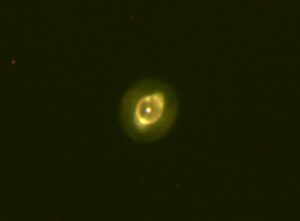
First Part of the workshop for teachers (Fri, May 15, 2020)
Program:
- Introduction of participants
- Explanations of the function of the virtual conference room
- Presentation of the working environment of the LCO telescopes
- Creating own work orders for the LCO telescopes; targets: M9 ; M13 ; M27 ; M57 ;
- NGC3242 ; C/2017 T2 (PanSTARRS)
- Homework
- Further planning
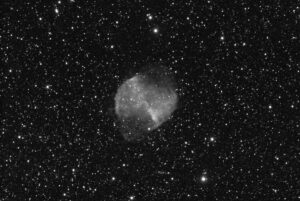
Second part of the workshop for teachers (Tue, May 19, 2020)
Program:
- Asteroid hunt (remote session, if possible)
- Download of fit-packages from LCO sience archiv
- Unpack LCO archive files
- Download and install the Astrometrica software
- Creation of MPC reports with Astrometrica
- Results
- Homework
- Further planning
Some of the observations (this time using FTN) in this session were used to confirm that newly discovered asteroid NEO 2020 KN1 was an Amor type:
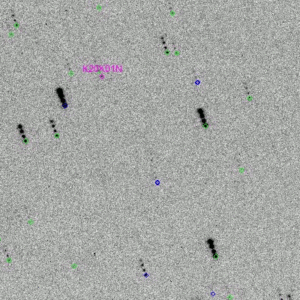
Images obtained 2020 05 19 ; 14:16:31 – 14:28:55 UT
4 images, each stacked, 4 x 15s
A day later, the discovery and confirmations were accepted by the Minor Plant Center with the following Minor Planet Electronic Circular being issued:
2020 KN1 = C2TAZN2 (May 20.19 UT) [see MPEC 2020-K80]
Orbit type: Amor||Near-Earth Object [ Animation ]
Telescope: F65 – Haleakala-Faulkes Telescope North
Name: 2020 KN1
Observers: M. Weiermann, N. Reinhard, T. Sieger, L. Broering, P. Breitenstein.
Measurers: M. Weiermann, L. Broering, P. Breitenstein.
